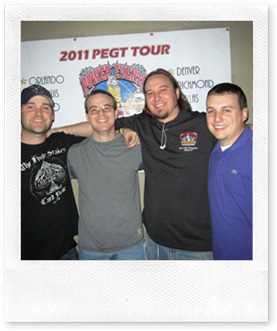Olympic mascots tend to have a few things in common.
They tend to be cuddly little buggers that look good stuffed. They tend to be cutesy. And they tend to be completely and utterly forgettable. (Quick: try to remember what any Olympic mascot looks like. Hmmmm. I think that at one point the Russians had some kind of cutesy, cuddly bear – the only cutesy, cuddly anything to come out of Russia since the Faberge egg.)
Well, other than a certain weird resemblance to the Teletubbies – if the Teletubbies were shiny, steely, and angular, as opposed to round and squishy. – there’s nothing cute or cuddly about the London Olympic mascots. If you haven’t seen them already, I give you Wenlock and Mandeville.
I don’t know about you, but I won’t be curling up with one of these little critters. No thumb-suckers need apply.
The thing I find most disturbing about this dynamic duo is not their not-so-heavy metal. It’s that creepy, Cyclops spy-cam that appears to be the only facial feature they sport.
I have read virtually nothing about these mascots, but are they supposed to be a takeoff on the surveillance/security cameras that, as I understand it, are fairly ubiquitous throughout Britain?
As if we need yet another reminder that privacy is becoming a very foreign object, virtually unknown as we all become more and more virtually known.
As a blogger who doesn’t post anonymously, and who writes on occasion (and within limits) about personal matters, I’m obviously not someone who insanely guards my personal privacy.
But it took me forever to breakdown and get a CVS card because I didn’t really want them knowing my toothpaste brand, my fondness for red licorice, and the exact date when menopause set in and I know longer had to buy tampons.
Ditto the grocery store. Sure, if Blue Cross/Blue Shield wants to nose in on what I buy at Whole Foods they’ll find plenty of healthier-than-thou fruits, veggies, and yogurt. But I really don’t want them to know that. Or to cross check with CVS and tally up how often I breakdown and spring for a bag of Twizzlers.
And I really despise how every other google search seems to end up haunting me for weeks after I make it.
I went to a Red Sox game a couple of weeks ago, and the guy in front of me had a cap with a vintage 1950’s BoSox logo, that looked more or less like this:

Okay, so as mascots go, this is every bit as creepy and sucky as the London Olympics mascots. Still, I’m rather fond of it and was curious about where I could find a cap sporting it.
Since my simple hunt for the weird red logo, I cannot go on any news site without being bombarded with images of Red Sox caps. (Trust me: when I find a cap I like, I’ll buy it. I just don’t want to have to think about it morning, noon and night.)
A few weeks ago, when I was trying to figure out whether I had carpal tunnel syndrome or MS – carpal tunnel, by the way - I searched a bit on neuropathy.
When I’m not being bombarded by cap vendor, I’m besieged by links to something-or-other about neuropathy. I have chosen not to click on any of those links.
I know that some folks may appreciate the “convenience” of having objects of erstwhile interest appear on their screens unbidden. After all, just because I didn’t find it necessary to purchase yet another Red Sox cap in hopes that it would cure carpal tunnel, doesn’t mean that the next guy wouldn’t be pleased that vendors were trying to meet their needs.
But it does want to make me save up my searches and take care of them at the library, where I’d no doubt have to line up with creeps checking out peep show sites. (But where hopefully I wouldn’t have to swipe my library card before I launched my search for carpal tunnel.)
Then there’s the seeing-eye on my computer. Once in a while, as long as I’m wearing something other than my bathrobe, I’ll activate it for an online meeting. But for a long while, fearing that someone could figure out how to remotely activate it and start spying on me, I plastered a band-aid over it.
Of course, we also have all those security cameras.
Sure, I’m always interested when the good guys catch the bad guys because the security cam at the 7/11 or gas station caught everything in herky-jerky black and white. But the idea of having a security camera on every corner watching for red light runners and jay-walkers (I’m in trouble), nose pickers and grimacers, cheating spouses and distracted parents…. Have we become so paranoid about safety that we want to have spy cams everywhere?
Maybe the London Games mascots are on to something.
We’ve all got smartphone cameras. We’re just a hop, skip and a long-jump from embedding cameras in our foreheads so we can record everything we come across 24/7, including videos of ourselves uploading our cam output onto YouTube. Maybe eventually we’ll all evolve to look like Wenlock and Mandeville.
I guess I’ve seen the future and it’s neither cuddly nor cute. It’s the human as spy-cam.
Wheeeee!











